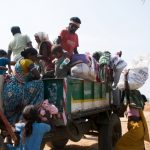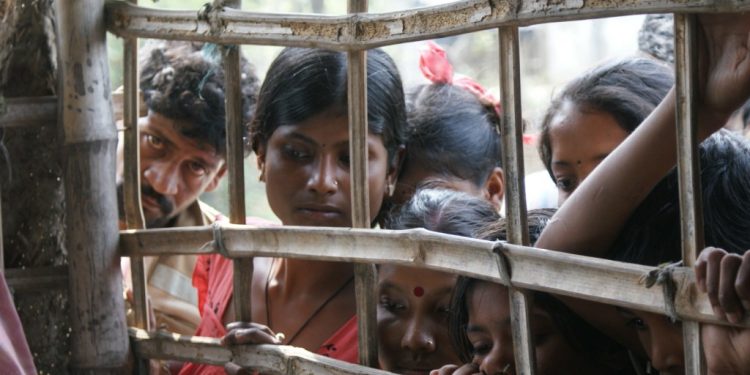Environmentalists and experts opine that women and children among Odia migrants who flee the state due to effects of climate change are trafficked due to their vulnerability
BHUBANESWAR: Jagannath Barik (name changed) of Gunadalba village in Puri led a content life with his mother, wife and two daughters. However, life took a vicious turn last year when the insidious rise in sea water eventually consumed his farmland.
Left with no land to make ends meet and limited source of income, Jagannath was forced to find an alternative. With the help of a middleman, he along with his wife and two daughters, Snigdha and Sasmita aged 13 and 9 respectively, migrated to Pune to work in a construction firm.
Few months later, Jagannath’s daughter Sasmita has now been missing for about a year. Local police suspect a case of human trafficking and are still in search of her.
Cases such as Jagannath’s are not few and far between. Environmentalists and experts here have said that there will be an increase in such incidents affirming a direct relation between climate change and women and child trafficking.
“Soil degradation, excess rains, rise in temperatures, cyclones and lack of clean water are just glimpses of what the climate change is doing to us. These things are having a direct impact on the people of our state, especially the poor,” said Shubendhu Tripathy, an environmental activist.

“Natural disasters and other environmental changes are forcing people to migrate in search of a better livelihood and Odisha needs to more careful with high rates of migration,” he added.
In the past two decades, Odisha’s geographic location on the east coast of India has made the state experience contrasting weather conditions claiming many lives and rendering a number of people homeless.
According to a 2014 study by Integrated Coastal Zone Management Project (ICZMP), around 10 per cent of Odisha’s coastline in the districts of Puri, Kendrapara and Ganjam is vulnerable to sea erosion. “From 1999 to 2016, about 154 km of the 480 km of shoreline has been lost. This is mainly due to changing wind patterns causing high tidal waves, and the water constantly inundating habitable areas,” the study said.
Furthermore, while 13 districts this year sweltered under intense heat wave with temperatures soaring above 40 degrees Celsius, a study done by IIT-Bhub revealed that local surface temperature has gone up by 40 to 50 per cent between 2001 and 2010 in the capital city. This was coupled with the state receiving 9.9% excess rainfall as mentioned by Revenue and Disaster Management.
“These contrasting temperatures greatly affect the agricultural produce and farmers are the worst-affected. It forces them to migrate to other states to pay off their debts which middlemen pay as ‘advance’ ranging from Rs 20,000 to Rs 60,000 to meet their critical emergencies or settle their previous debts,” explained Smita Das, who works for an NGO involved in rescuing migrant labours.
According to government figures, Odisha has shown a rapid increase in migrant labours. While only 55,000 workers left Odisha in 2007, 1.05 lakh left in 2012, 1.2 lakh in 2013, 1.35 lakh in 2014, 1.46 lakh in 2015 and 1.93 lakh last year. However, activists like Smita believe that the numbers are much more as many of these don’t register themselves to official authorities.
A report by India Country Assessment Report on anti-human trafficking said that West Bengal, Andhra Pradesh, Karnataka, Maharashtra, and Odisha are common source areas for trafficking to red-light areas across India. Children and women are said to be the worst affected.
The State Crime Records Bureau’s (SCRB) data last year suggested that the missing children reports filed stood provisionally at around 905. Similarly, the number of adult women gone missing in the same period in the state stood at around 1,450. While Keonjhar registered maximum cases of girl child missing, Sundergarh had highest missing women cases.
However, a senior official at Labour and Employment Department denied any co-relation between environment and trafficking and said, “The state has indeed a high migration percentage but their movement are motivated by number of factors and cannot be solely attributed to climate change. However, climate change cannot be completely ignored and the state government has formulated a comprehensive action plan for it.”
Alarming Trend
Climate Change
From 1999 to 2016, the state lost about 154 km of 480 km-long coastline due to rise in sea level. This year, 13 districts sweltered under intense heat waves with temperatures soaring above 40 degree Celsius and the state received 9.9% excess rainfall
Impact
Excess rains, rise in temperatures and lack of clean water adversely affect the poor populace of Odisha who migrate to other states. While 55,000 workers migrated from the state in 2007, 1.93 lakh left in 2018. 905 children and 1,450 women among these migrants are reportedly missing due to alleged human trafficking
Aviral Mishra, OP






































